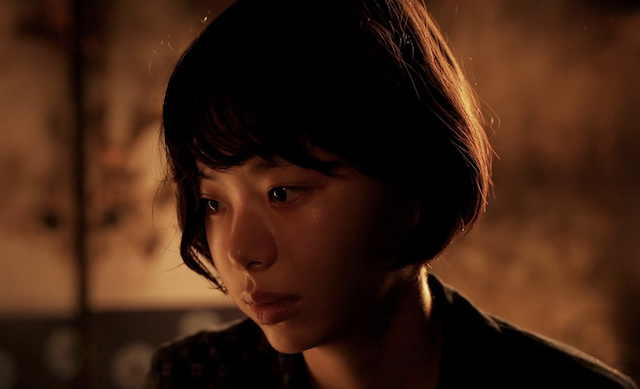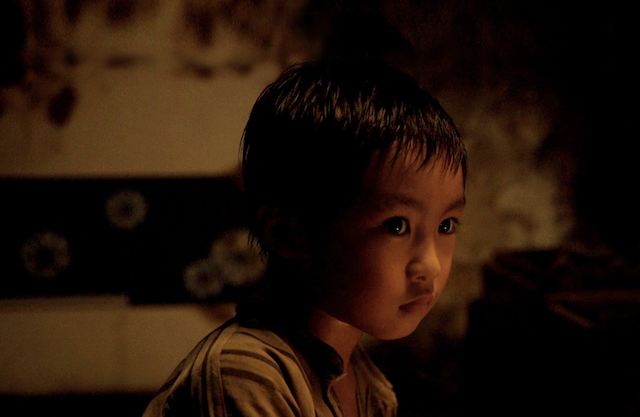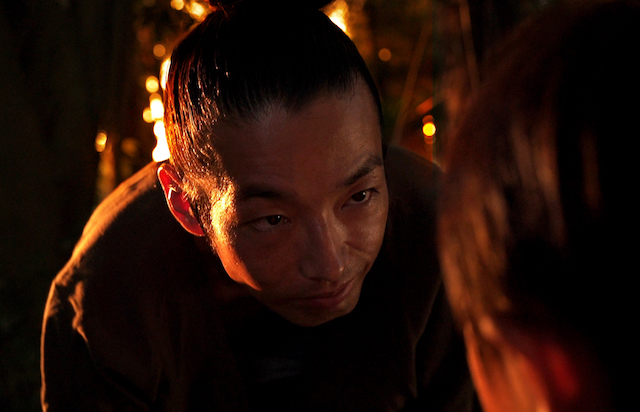
©Courtesy of Japan Cuts
The centerpiece film of this year’s Japan Cuts, Shadow of Fire is the third feature in Shinya Tsukamoto’s “War” trilogy, following his previous works Fires on the Plain and Killing. Renowned for his mastery in creating intense atmospheres and exploring visceral subject matter, Tsukamoto once again draws audiences into the harrowing world of war’s shadow and fear.
Shadow of Fire focuses on a war orphan, portrayed by the young Ouga Tsukao (who was only six years old at the time!), struggling for survival in the immediate post-war devastation. The child encounters a young widow (Shuri), who resorts to selling her body in a tavern, a traumatized young soldier (Kono Hiroki), and a mysterious one-armed vendor (Mirai Moriyama), who secretly plans his dark vengeance. While delving into post-war psychology similar to the previous films in the trilogy, the director presents life in the aftermath from a worm’s-eye perspective.
On the day of the film’s U.S. premiere, Cinema Daily U.S. had the opportunity to speak with Tsukamoto at a press roundtable, where he was joined by actor Mirai Moriyama, who won the 2024 CUT ABOVE Award. Despite the limited time, the Japanese director generously shared his creative insights and the inspiration behind this gut-wrenching period drama.

©Courtesy of Japan Cuts
Q: What made you want to have a child protagonist?
Shinya Tsukamoto: The main reason is that I wanted the film to serve as a prayer for a bright future for the younger generation. In the event of future conflicts, it will be the young people who will be on the front lines.
Q: The film successfully portrays the horrors and devastation of war, even though it doesn’t have a battlefield scene. In fact, the first half of the film unfolds in the very confined space of a run-down tavern. What did you struggle with the most while depicting this subject matter without a grand setting?
Shinya Tsukamoto : I had long felt a cinematic fascination with the subject of the post-war black market (yami-ichi) and wanted to write a story structured around the chaotic nexus of people and businesses there. However, depicting the entire picture of the vast world of a black market would exceed the budget, so I needed to scale it down. Before narrowing my scope, I first drafted a plot and laid out all the details I would include in a film if there were no financial or logistical restrictions. I fleshed out those micro-details, which became side stories that weren’t shown in the film but were essential to the main storyline set in the small space of the tavern. By constructing these detailed side stories, the narrative became concrete enough to convey all the messages and atmosphere I intended, even though the action was confined to a single location.
Q: This film has been shown around the world and will continue to be. Given the fact that some countries are currently facing political crises and violence, what kind of thoughts or feelings would you like the people watching this movie to have?
Shinya Tsukamoto: Linking to my previous answer about why I chose a child as the protagonist, the most painful thing for me right now is seeing the news almost every day about children in Gaza suffering. Since this is actually happening on the ground, we must not look away. Rather, we should face reality and take action, though I acknowledge that it can be difficult to know what to do. It’s something we need to find a way to address. This film features children as the main characters, and it was made with the hope that when these children grow up, they won’t have to live in a state of war.
I want the viewers to ‘feel’ this alarming sentiment, not necessarily comprehend it; as the film doesn’t provide detailed explanations in the historical context of the time the story is set, it might not get across to young Japanese people, let alone international audiences. But I hope the urgency of this message would be sensed by those who watch it on a gut level. If they resonate with something in the film, I hope they can be moved to say ‘wait a minute’ before allowing the situation to drift into war.”
Q: What does it mean to you to have elements of violence in your films? From Tetsuo: The Iron Man to Killing, even in this Shadow of Fire, it seems like sort of like a recurring theme throughout your filmography.
Shinya Tsukamoto: Earlier in my filmmaking career, with films like Tetsuo, I considered violence as an entertainment element, much influenced by the manga culture and the films of the American New Wave that I grew up consuming. I believe an inclination toward violence is a natural human disposition that we all possess, either consciously or subconsciously. I used to prefer expressing this in my films rather than sweeping it under the rug. There was also a phase in my career where I depicted violence as a way to ground characters in a sense of being alive. Having lived in a big city, I’ve sometimes felt detached from a sense of life. Much like pinching one’s cheek to test whether one is alive or dead, my characters voluntarily inflict pain on others and themselves, desperately seeking a sense of living.
After some time, around when I made Fires on the Plain, violence started feeling more imminent; as the possibility of war became more impending, my desire to treat violence as entertainment diminished. I’ve made films with violence to convey a deterrent message: to avoid reaching a state of violence that is truly atrocious and harrowing.

©Courtesy of Japan Cuts
Q: All the characters in the film aren’t given names. Was this an intentional choice? If so, what was your intention behind it?
Shinya Tsukamoto : I didn’t set out to do this intentionally, but similar to Tetsuo, where characters are named “Man,” “Woman,” and “Him,” I wanted the story to remain symbolic by keeping the characters’ identities abstract.
Even though everyone has their own name, people who died in war are often reduced to mere numbers. This detachment is disturbingly simple and impersonal. By not giving names to the characters, I aimed to highlight the idea that each person had a unique life, and to portray the variety of individual experiences and lives. It was only when I was writing the revenge scene for Mr. Moriyama’s character, where he calls out the names of his fallen comrades, that I realized the impact of this choice. When I finally wrote down his name, which is revealed in the film, I was struck by its dynamic significance.
If you like the article, share tour thoughts below!
Check out more of Mako’s articles.
Here’s the trailer of the film.

